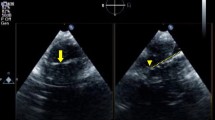Abstract
Total aortic arch replacement using the frozen elephant trunk (FET) procedure has widely spread all over the world with more sophisticated devices. However, spinal cord injury is one of the most important complications, which limits the use of FET. In our hospital, 80 patients treated with FET had no spinal cord injury. There are three key points to avoid spinal cord injury, (1) The distal end of stent graft should be positioned up to the eighth thoracic vertebrae level; (2) the time for selective left subclavian artery perfusion and distal body circulatory arrest should be shortened within 60 min; and (3) mean blood pressure should be maintained above 70 mmHg. Especially, Key point (1) is the most important. The level of aortic valve, which locates around the seventh thoracic vertebrae level, is an appropriate benchmark. We implanted the stent graft with the use of transesophageal echocardiography guided three-step method.




Similar content being viewed by others
References
Kato M, Ohnishi K, Kaneko M, Ueda T, Kishi D, Mizushima T, et al. New graft-implanting method for thoracic aortic aneurysm or dissection with a stented graft. Circulation. 1996;94(Suppl):II188–I93.
Thron AK. Vascular anatomy of the spinal cord: neuroradiological investigations and clinical syndromes, vol 7. Springer, New York. 1988. pp. 3–65.
Katayama K, Uchida N, Katayama A, Takahashi S, Takasaki T, Kurosaki T, et al. Multiple factors predict the risk of spinal cord injury after the frozen elephant trunk technique for extended thoracic aortic disease. Eur J Cardiothorac Surg. 2015;47:616–20.
Ma W-G, Zheng J, Sun L-Z, Elefteriades JA. Open stented grafts for frozen elephant trunk technique: technical aspects and current outcomes. AORTA (Stamford). 2015;3:122–35.
Uchida N, Katayama A, Higashiue S, Shiono M, Hata M, Minami K, et al. A new device as an open stent graft for extended aortic repair: a multicentre early experience in Japan. Eur J Cardiothorac Surg. 2016;49:1270–8.
Author information
Authors and Affiliations
Corresponding author
Ethics declarations
Conflict of interest
Kazuo Yamanaka is a consultant of Japan Lifeline, Tokyo, Japan.
Rights and permissions
About this article
Cite this article
Yamanaka, K., Ishii, H. Three-step method for transesophageal echocardiography-guided implantation of the frozen elephant trunk: how to prevent spinal cord injury. Gen Thorac Cardiovasc Surg 67, 340–343 (2019). https://doi.org/10.1007/s11748-018-0938-6
Received:
Accepted:
Published:
Issue Date:
DOI: https://doi.org/10.1007/s11748-018-0938-6




